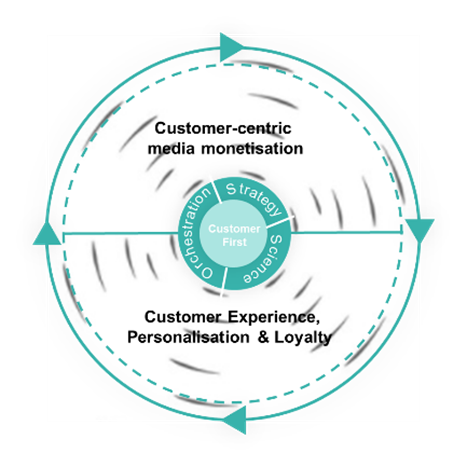The flywheel effect that comes with great CRM
When it comes to the question of how best to grow profits in the grocery sector, much of the recent focus has been on retail media – and rightly so. Capable of generating substantial incremental revenues, and with extremely healthy margins to boot, retail media can make a world of difference to a retailer’s bottom line.
While this is obviously appealing, retailers need to continue to invest in building great customer experiences, engaging customers so brands want to invest in their retail media offering. And that, as the title of this post has no doubt already given away, is where CRM – or Customer Relationship Management – comes in.
Customer loyalty plays a critical role in any retailer’s success. The stronger the relationships that retailers build with them, the more valuable customers become. This isn’t just received wisdom, either; not only do a number of independent studies demonstrate the positive impact of customer loyalty, our own RPI Series draws a tangible link between“emotional connection” and commercial success.
While there are many ways for retailers to drive loyalty, one of the most effective is through the use of strategic CRM programmes. Here, the focus is on improving the customer experience through the use of behavioural data, allowing retailers to create more relevant rewards, offers, and communications. Not only does this help to show customers that the retailer understands them, it typically opens up a range of new commercial opportunities too.
This is something we’ve seen firsthand in our own work with grocery banners around the world. At one European multiformat, for instance, we saw 45% customer participation, a 32% redemption rate, and 2% like-for-like sales uplift when introducing a new personalised CRM programme. The 4:1 sales-to-cost ratio is testament to the potential that Customer First CRM can hold.
As important as the short-term returns are, though, one of the greatest things about an effective CRM programme is that it can also drive a cycle of continuous improvements that help retailers to unlock the true value of their customers.
Better for your customers, better for you
Call it a flywheel, virtuous circle, or something else entirely, a cycle of continuous improvement is based on the principle that what you do in one part of your organisation makes something better elsewhere. That then drives further improvements, and so on. As these wins build up, so too does the overall momentum, creating a process that – eventually – becomes self-sustaining.
In terms of CRM specifically, I think there are two things that can help to get that flywheel spinning.
First, there’s the customer experience, where the use of personalisation can help to grow loyalty and drive sales uplift. That, in turn makes a retailer more attractive to brands, which helps to attract financial investment in the form of media and insight revenues. Allocated wisely, that money can then be used to further enhance the customer experience, which subsequently… well, you get the point.

Better customer experiences drive sales, which make a retail business moreattractive to CPG advertisers. The revenues generated can then be reinvested into the customer experience.
In these terms, a well-implemented CRM programme can serve as a catalyst, accelerating and strengthening this process. For it to do so, however, retailers need to make good use of their customer data, creating the insights into preferences, purchase histories, and behavioural patterns needed to shape the grocery experience around their needs.
There are numerous techniques that can be employed when seeking to make that a reality. For instance:
- Segmenting a customer base allows relevant offers to be sent with greater accuracy and effectiveness.
- A deeper understanding of purchasing habits allows preventative measures to be used when a customer shows signs of lapsing or downtrading.
- Knowledge of customer preferences can be used to streamline the shopping experience, with recommendations and inspiration making things faster and easier.
Essentially, the more time that retailers spend on their CRM programmes, the more effective their entire operation is likely to become – and that’s essential to get that flywheel in motion.
Watchouts remain
With all of the above said, there are still challenges to overcome and new tools that can be integrated. Some of the major considerations include:
- Your offer pool, which needs to reflect the needs of customers. If CPGs focus solely on niche products for personalised offers, for instance, then the overall relevance of your pool is likely to decrease. That will lead to fewer redemptions, and less investment; the exact opposite of what’s desired.
- Your omnichannel experience, which needs to give customers a range of redemption opportunities. More than anything, the offer pool you create needs to be accessible wherever someone happens to be on their shopper journey: bring the offers to them, rather than asking them to come to you.
- A frictionless approach, where a seamless process is the priority. If you’re going to ask customers to download and sign in to an app, for instance, you need to give them the ability to make a purchase as well as activating a coupon. Unnecessary steps are hurdles in disguise.
- AI and machine learning, which could be used to deliver further refinements. These technologies can process vast amounts of customer data, identify key patterns, and predict future behaviours – all of which can be used to create greater standards of personalisation and deliver tailored recommendations.
Building a stronger relationship with customers is crucial to a retailer’s long-term success. The better you know them, and the more that you’re able to put their needs first, the greater the rewards will be. Any investments you make in your CRM programme will ultimately drive impact elsewhere, creating the cycle of improvements you need to unlock the true value of your hard-won customer base.
TOPICS
RELATED PRODUCTS
Create optimal ranges with retailers to achieve your assortment goals
Maximise returns on promotionsThe latest insights from our experts around the world



